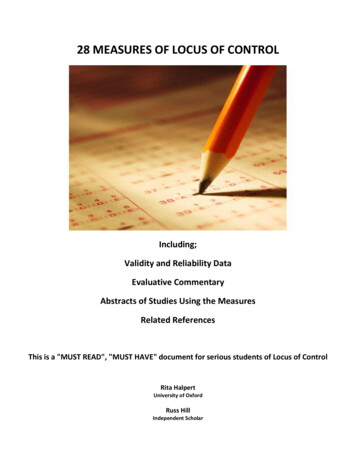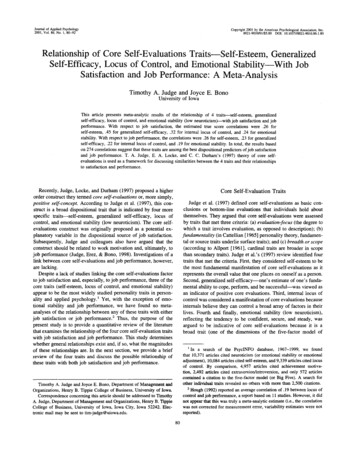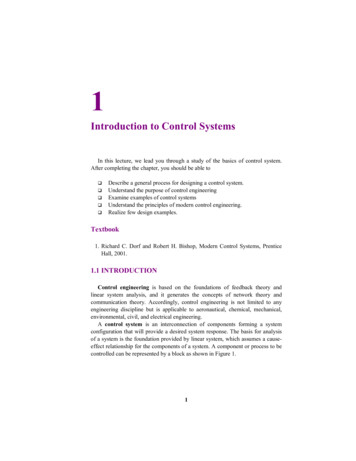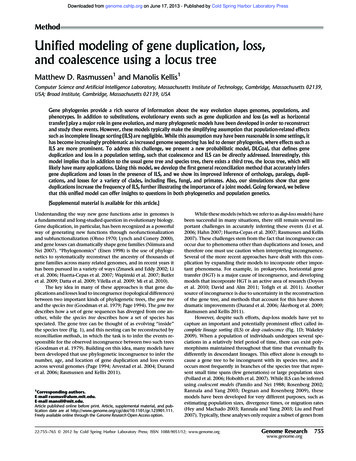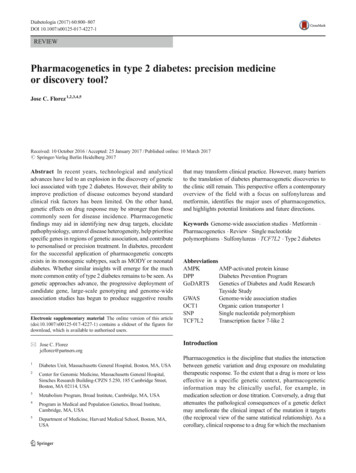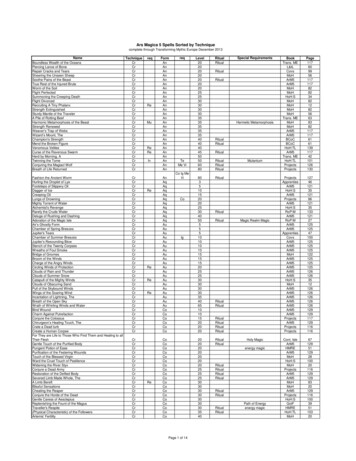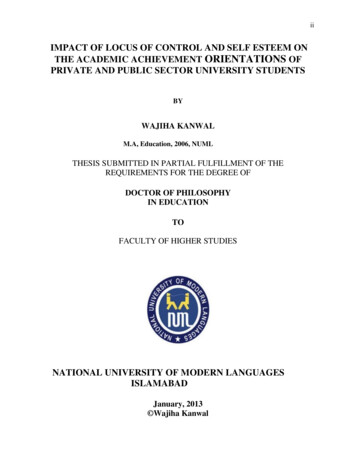
Transcription
iiIMPACT OF LOCUS OF CONTROL AND SELF ESTEEM ONTHE ACADEMIC ACHIEVEMENT ORIENTATIONS OFPRIVATE AND PUBLIC SECTOR UNIVERSITY STUDENTSBYWAJIHA KANWALM.A, Education, 2006, NUMLTHESIS SUBMITTED IN PARTIAL FULFILLMENT OF THEREQUIREMENTS FOR THE DEGREE OFDOCTOR OF PHILOSOPHYIN EDUCATIONTOFACULTY OF HIGHER STUDIESNATIONAL UNIVERSITY OF MODERN LANGUAGESISLAMABADJanuary, 2013 Wajiha Kanwal
iiiNATIONAL UNIVERSITY OF MODERN LANGUAGESFACULTY OF HIGHER STUDIESTHESIS AND DEFENSE APPROVAL FORMThe undersigneds certify that they have read following thesis, examined the defense, are satisfiedwith the overall performance and recommended the thesis to the Faculty of Higher Studies foracceptance;Thesis Title:Impact of locus of Control and Self-Esteem on the Academic Achievement Orientations ofPrivate and Public Sector University StudentsSubmitted By: Wajiha KanwalRegistration # 278 M.Phil/Edu/2007 (January)Name of studentDoctor of PhilosophyDegree Name in fullEducationName of DisciplineDr. Fauzia KhurshidName of Research SupervisorSignature of Research SupervisorDr. Shazra MunnawarName of Dean (IHS)Signature of Dean (FHS)Maj Gen. (R) Masood HassanName of RectorSignature of RectorDate
ivABSTRACTTABLE OF CONTENTSChaptersDissertation & Defense Approval FormAbstractTable of ContentList of TablesList of AcronymsDedicationAcknowledgementPages Noiiiivv-xxi-xivxvxvixxiiCHAPTER – I- INTRODUCTION1.0 Introduction1.1 Background of the Study1.2 Operational Definitions1.2.1 Self Esteem1.2.2 Locus of Control1.2.3 Achievement Orientations1.3 Statement of the Problem1.4 Objectives of the Study1.5 Hypotheses the Study1.6 Delimitations of the Study1.7 Procedure1.8 Population1.9 Sample1.10 Research instruments1.10.1 The Factor Loading Self Esteem Scale1.10.2 The Rotter’s Internal-External Locusof Control Scale1.10.3 Achievement Orientation Attitude 7-18
v1.11 Administration of Research Instruments1.12 Collection and Tabulation of DataSummary181819CHAPTER-II - REVIEW OF THE RELATED LITERATURE2.1 What is Locus of Control?2.1.1 History o f the Concept2.1.2 Correlates Locus of Control2.1.3 Locus of Control and Personality Orientations2.1.4 Locus of Control and Cognitive Activity2.1.5 Locus of Control and Socio economic Status2.1.6 Locus of Control and Psychopathology2.1.7 Locus of Control and Achievement related behavior2.1.8 Locus of Control and Coping behavior2.1.9 Locus of Control and Childrearing practices2.1.10 Gender Based Difference in Locus of Control2.1.11 Cross Cultural Issues in Locus of Control2.1.12 Academic Locus of Control2.2What is Self2.2.1 Self Awareness2.2.2 Development of Self Concept2.2.3 Maslow’s Theory2.2.4 Self Efficiency Theory2.2.5 Self Theory2.2.6 Description of the Witnessing Self2.2.7 Descriptions of the Observing Self2.2.8 Role of Self in Personality Development2.2.9 Self Evaluation2.2.10 Self Knowledge2.2.11 Self Regulation2.2.12 Self Acceptance2.2.13 Self Competence2.2.14 Academic Self Competence2.2.15 Physical and Social Acceptance2.2.16 Theoretical Framework of Self esteem2.2.17 Components of Self Esteem2.2.18 History of Self Esteem 33-3434-373738- 5454 -5555-5657-5858-5959-6161-6969-7070-74
2.602.2.61Positive or High Self EsteemNegative or Low Self EsteemBasic Assumptions Regarding Self EsteemSelf esteem Is DynamicSelf esteem Is LearnedSelf esteem Is OrganizedBasis of Self EsteemPsychological Basis of Self EsteemSociological Basis of Self EsteemCognitive Development ApproachesThe Information Processing ModelEnvironmental/ Learning TheoriesThe Need and Development of Self EsteemCriteria of Self EsteemThe Six Pillars of Self esteemMeasurement of Self EsteemMajor Self Esteem TheoriesSocial ApproachesHumanistic ApproachDevelopment ApproachSocio Meter TheoriesTerror Management TheoryParental Factors in Self esteemParental Expectations and ConsistencyBirth OrderGeneticsParental WarmthParental StyleModelingParental SupportRole of Gender in Self Esteem DevelopmentAnd Related ResearchesRole of Education in Self Esteem Developmentand Related ResearchesFactors Affecting the Developing the Self EsteemLanguageIdentificationSocial FeedbackParent-Child RelationshipsTeacher Pupil RelationshipPeer RelationshipPhysique, Aptitude and TemperamentPersonal Success and Failure or NeedFor Positive RegardPersonality Theories Self esteemCognitive 4-125125
3.12.3.22.3.3Behavioral PerspectivePsycho Analytic PerspectiveHumanistic PerspectiveSelf esteem and Socio Economic StatusSelf Esteem and GenderEthnic Differences in Self EsteemLocus of Control and Self EsteemDefinitions achievement OrientationsAcademic Self conceptAcademic Performance Determines Self esteemLevel of Self esteem determines theDegree Academic Achievement2.3.4 Structure of Academic Self Esteem2.3.5 Frame Reference Effects On Self Esteem2.3.6 Reference Group Comparison2.3.7 Measurement of Academic Self Esteem2.3.8 Academic Failure2.3.9 Causes of Academic Failure2.3.10 Institutional Readiness2.3.11 Academic, Instructional, and Motivational Reasons2.3.12 Physiological, Neurological and Cognitive Reasons2.3.13 Preventing Academic Failure2.3.14 Types of Academic Problems2.3.15 Selecting Achievement Orientations2.3.16 Implementing Achievement Orientations2.3.17 Evaluating Achievement Orientations2.3.18 Achievement Orientation Targets2.3.19 Causes of Student Achievements2.3.20 Economic Resources2.3.21 Family 167-168CHAPTER-III- METHODOLOGY3.1 Research Design3.2 Population the Study3.3 Sample the Study3.4 Research Instruments3.5 Part I- Pilot Testing3.5.1 Sample of pilot study3.5.2 Procedure3.5.3 Analysis of Data3.5.4 Results of Pilot Study3.5.5 Validity of Research Instruments3.5.6 Reliability of Research -173173173-174
viii3.6 Items Total Correlations3.7 Part II- Main Study3.7.1 Sample3.7.2 ProcedureSummary174-178179179-180180180CHAPTER-IV - RESULTS4.1 Results of the Main Study4.2 Inter Scales Correlations4.3 Percentile Ranks4.3.1 Level of Dimension of Self Esteem4.4 Gender Wise Comparison of Self esteem4.5 Semester Wise Comparison of Self esteem4.6 Discipline Wise Comparison of Self esteem4.7 Birth order Wise Comparison of Self esteem.4.8 Family Income Wise Comparison of Self esteem.4.9 Number Sibling Wise Comparison of Self esteem.4.9.1 Sector Wise comparison of Self Esteem4.10 Split Half Reliability of Locus of Control4.11 Percentile Analysis Locus of control.4.11.1 Level and Dimension of Locus of Control4.12 Gender Wise Comparison of Locus of control4.13 Age Wise Comparison of Locus of Control4.14 Semester Wise Comparison of Locus of Control4.15 Discipline Wise Comparison of Locus of Control4.16 Birth order Wise Comparison of Locus of Control4.17 Family income Wise Comparison of Locus of Control4.18 Number of siblings Wise Comparison of LocusOf Control4.19 Sector Wise Comparison of Locus of Control4.20 Reliability4.20.1 Split Half Reliability Locus of Control4.21 Item Total Correlation4.22 Percentile Ranks Achievement orientation attitude scale4.23 Level and Dimension of Achievement orientationAttitude scale4.24 Gender Wise Comparison on AchievementOrientation attitude scale4.25 Age Wise Comparison on 02203
ixOrientation attitude scale203-2044.26 One-Way Analysis of Variance for students scorefor variable age on Achievement Orientation Attitude Scale2044.27 Semester Wise Comparison on AchievementOrientation attitude scale204-2054.28 Discipline Wise Comparison on AchievementOrientation attitude scale2054.29 Birth order wise Comparison of Achievement205-2064.30 Family Income Wise Comparison on AchievementOrientation attitude scale206-2074.31 Number of siblings Wise Comparison on AchievementOrientation attitude scale2074.32 Sector Wise Comparison on Achievement Orientation Scale 2074.36 Relationships of the Locus of control, Self EsteemAnd Achievement Orientations208-209CHAPTER-VSUMMARY, DISCUSSION, ings5.4Conclusions5.5Recommendations5.5.1 Recommendations for University Teachers5.5.2 Recommendations for University Management5.5.3 Recommendations for University Students5.5.4 Recommendations for Parents5.6Applied Significance5.7Limitations and Suggestions for further PENDICESAPPENDIX AAPPENDIX BAPPENDIX CAPPENDIX DAPPENDIX Ei-xviIntroductionList of universities from where Data wascollected.Demographic Characteristics of the Sample ofthe Main StudyDemographic Information Sheet FactorLoading Self Esteem Scale(29 items)Factors Loading Self Esteem Scaleiii-ivv-viiViiiix-xi
xAPPENDIX FAPPENDIX GRatter’s Locus of Control Scale (29 items)Achievement Orientation Attitude Scale(10 items)xii-xivxv-xviImpact of Locus of Control and Self Esteem on the AchievementOrientations of Private and Public Sector University Students.
xiWajiha kanwal,Ph.D Research ScholarAbstractTitle: Impact of Locus of Control and Self Esteem on the Academic AchievementOrientations of Private and Public Sector University StudentsProblem of the study was to explore the impact of locus of control and self-esteem on theacademic achievement orientations of private and public sector university students, it furtheraimed to investigate the impact of demographic variations such as gender, age, discipline,number of siblings, birth order, family income in determining the type of locus of control, levelof self-esteem and level of academic achievement orientations of private and public sectoruniversity students. In this study for the measurement of self esteem Factor Loading Self EsteemScale developed by Rifai was used (1999), it was consisted of 29 items and 4 factors such asSelf Acceptance, Academic Competence, Physical & Social Acceptance, and Self Competence.For the measurement of locus of control Rotter’s Locus of control Scale consisted of 29 itemswas used. Achievement orientation attitude scale developed by Ansari was used to measureachievement orientations, which was consisted of 10 items. Rresearch was carried out in twoparts, part I was pilot study which was carried out on a sample of 100 Master level universitystudents. After data collection, psychometric properties were determined and scales werefinalized for main study. Part 2 was consisted of main study in which data was collected throughstratified random sampling technique. The sample consisted of 510 respondents among them 256were male and 254 were female students belong to various departments of 138 from socialsciences,130 from natural sciences,122 from management sciences and 120 from humanities .Data was analyzed with various statistics, results provided an insight that students differ in termsof self-esteem, locus of control and achievement orientations, higher academic achievementorientations create love for learning and a sense of internal locus of control in the learners thatenable learners to exhibit higher motivation towards their academics without extrinsic rewards.Results revealed that students of public sector universities have internal locus of control, higherself-esteem and higher achievement orientations. Female students have higher self-esteem andachievement orientation , whereas male students have internal locus of control. It isrecommended that teachers may use appropriate pedagogical and motivation practices toinculcate internal locus of control, higher self-esteem and higher academic achievementorientations among university students. It is also recommended that at university level studentsmay also learn self-management and develop internal locus of control, positive self-esteem andought to work hard in order to achieve their academic goals without external push.
xiiiLIST OF TABLESTableTITLESPage No.No1Items Total Correlation for respondents scores on FactorLoading Self Esteem Scale2Items Total Correlation for respondents scores on Locus ofControl Scale3176-177Items Total Correlation for respondents scores onAchievement Orientation Attitude Scale4174-175178Items Total Correlation for respondents scores on FactorLoading Self Esteem Scale1825Inter Scales Correlations1836Percentile Ranks Respondents Scores on Factor Loading SelfEsteem Scale184-1857Level and Dimensions of Self Esteem1858Gender wise Comparison Respondents Scores on FactorLoading Self Esteem Scale9Semester wise Comparison of students Score on FactorLoading Self Esteem Scale1011One-Way Analysis of Variance of Private Sector and PublicSector University Students For the variables Semester for theirscore on Factor Loading Self Esteem ScaleDiscipline wise Comparison of students course on FactorLoading Self Esteem Scale12188188-189189-190Family Income Wise Comparison Respondents Scores onFactor Loading Self Esteem Scales14187Birth Order Wise comparison of Scores on factor Loading SelfEsteem Scale13186Number of Siblings Wise Comparison Students Scores on190-191
xivFactor Loading Self Esteem Scales15191-192Sector Wise Comparison of Private and Public SectorUniversities Student on Factor Loading Self Esteem Scales19316Split Half Reliability of Locus of Control19317Percentile Ranks of Respondents’ Score on Locus of ControlScale19418Level and Dimensions of Locus of Control Scale19419Gender Wise Comparison Respondents’ Scores on Locus ofControl Scale20212223Age Wise Comparison Students’ Scores on Locus of ControlScale196One-Way Analysis of Variance of Public Sector and PrivateSector University Students on Locus of Control for thevariable of Family IncomeSemester Wise Comparison Students’ Scores on Locus of196Control Scale197Discipline Wise Comparison Students’ Score on Locus ofControl Scale24197Birth Order Wise Comparison Students’ Score on Locus ofControl Scale25195198Family Income Wise Comparison Respondents’ Score onLocus of Control Scale198One-Way Analysis of Variance of Public Sector and PrivateSector University Students on Locus of Control for thevariable of Family-IncomeNumber of Siblings Wise Comparison Students’ Scores of199Locus of Control Scale19928Sector Wise Comparison of Locus of Control20029Split Half Reliability of Achievement Orientation Attitude2627Scale30Item Total Correlations of Respondents’ Score on200
xvAchievement Orientation Attitude Scale3132201Percentile Ranks of Respondents’ Scores on AchievementOrientation Attitude Scale201-202Level and Dimensions of Achievement Orientation Attitude202-203Scale33Gender Wise Comparison of Respondents’ Scores onAchievement Orientation Attitude Scale34203Age Wise Comparison of Students’ Scores on AchievementOrientation Attitude Scale204One-Way Analysis of Variance for Students Score for variableof Age on Achievement Orientation Attitude ScaleSemester Wise Comparison on Students’ Scores on204Achievement Orientation Attitude Scale205353637Discipline Wise Comparison of Students’ Scores onAchievement Orientation Attitude Scale38Birth Order Wise Comparison of Students’ Score onAchievement Orientation Attitude Scale39206Family Income Wise Comparison of Respondents’ Score onAchievement Orientation Attitude Scale40205207Number of Siblings Wise Comparison of Students’ Scores onAchievement Orientation Attitude Scale207Sector Wise Comparison on Achievement Orientation Scale2084142Relationship between Self Esteem and Locus of Control WithAchievement Orientation208
xvi43Relationship Between Self Esteem, Locus of Control andAchievement209
xviiLIST OF ACRONYMSDFDegree of FreedomFF RatioHHypothesisMMeanNNumber of ItemsPProbability ValueRCorrelationsSDStandard DeviationLOCLocus of ControlSESelf EsteemFLSEFactor Loading Self Esteem ScaleAOASAchievement Orientation Attitude Scale
xviiiDEDICATIONMy humble gratitude goes to ALLAH Almighty, for imbruing me with the strength andstamina to carry out this project, which in HIS mercy has held my hand whenever, I needed it.I dedicated this humble effort of mine, primarily with profound respect and honor to none elsebut to the most beloved PROPHET MUHAMMAD (Peace Be upon Him) who is the beacon oflight for me in this life and hereafter and Who best teacher for whole human kind .I also dedicated this work to my loving and caring mother, who has guided me towards rightpath of truth, at every stage in my life.I would also like to dedicate this work to my daughter Rabiya Noor who was suffered andneglected during my research.
xixACKNOWLEDGEMENTI owe lot to ALLAH Almighty for all HIS blessings and HIS Prophet Hazrat MUHAMMAD(Pbuh), who provides me courage and determination to complete my research work.I would like to extend my appreciation to (R) Maj Gen Masood Hassan Rector, NationalUniversity of Modern Languages and members of PhD synopsis approval committee, who kindlyapproved synopsis of my doctoral research. Special thanks are due to Dr. Shazra MunnawerDean, Faculty of Higher Studies for her encouragement, guidance and constant support duringthis research.I wish to express my deepest gratitude to Professor Dr. Allah Bakhsh Malik who hasprovided me scholarly guidance, expert opinion and encouragement during this study.Special gratitude is extended to my learned supervisor, Prof. Dr. Fauzia Khurshid forproviding me excellent supervision to conduct this research work effectively. Without her wiseguidance, critical arguments and continuous support, it would not possible for me to completethis work timely. Her excellent ideas and constructive criticism made this research workconstructive and innovative in the field of educational psychology.My deepest gratitude is due for my mother, who is my first teacher and source ofinspiration and guidance for me. I wish to express my special thanks to my brother who was aconstant source of strength for me throughout this long journey. Finally I express my love andappreciation to my beloved daughter “Rabiya Noor” who suffered and neglected many timesduring my doctoral research work.Wajiha Kanwal
1CHAPTER-IINTRODUCTIONUnderling locus of control is the concept of "self as agent," which means that our thinking affectsand control our actions, when students realize this function of thinking process then it couldpositively affect theircognitions, motivation, and ultimately academic performance. Theconcept of self can directly or indirectly, consciously or unconsciously regulate students’achievement orientations and intellectual processes in relation to their own intentions, setting ofgoals and conscious choices, in fact it can say to that self-choose to direct ones thoughts anddetermine drive toward the attainment of goals. University students’ behaviour is based ondifferent factors that are known as individual differences, among them self-esteem, locus ofcontrol and achievement orientations are major constructs that play a vital role in creatingindividual differences.Literature in the area of achievement orientations has revealed that all of abovementioned constructs have significant relationships with the affective, cognitive, and behavioralreactions of students in academic settings. Therefore, these constructs have received importancein educational and psychological studies. Since education significantly affects individuals’cognitions, temperament or adjustment, through process of education knowledge, cultural norms,values and skills are transmitted from one generation to another. Dewey defined it as “a processof reconstruction or reorganization of experience which adds to the meaning of experiences
2which increases ability to direct the course subsequently” (as cited in Samponath Pannerselvam,and Santhanam, 1990).Education is elementary foundation that brings changes in the societal configuration,economy and overall approach of the state. Education plays an important role for monetaryenlargement and its main foundation is to improve interrelated problems and accelerates the flowof the willingness amongst students to obtain knowledge and skills. It assists students toaccomplish acquaintance with new techniques and methods for national development, which isaccording to societal needs. Therefore, countries continue to upgrade education system as socialimprovement strategy. Developed countries mainly place even more stress on education in orderto fortify the capabilities and self-reliance of the youth.Education system coordination currently prevailing in Pakistan has number of stages, theearliest stage being primary stage extend over five years. This crucial stage of education isfollowed by three years middle stage (elementary education) and two years secondary stage.Then the intermediary or higher secondary stage begins which is generally part of collegeeducation. To get Bachelor’s degree additional two years of education is required or four yearshigher education is obligatory after ten years secondary education. University as an organizationis resolute by the belief, aims determined and goals of its patrons, namely, culture andadministration by requirements of its consumers, which are students, by its own inactivity orresist to change and by interior logic or need for reliability in its curricula and its programs.Imparting education is the major objective of higher education. Universities and highereducational institutions are known as tertiary, 3rd stage or post secondary education is the noncompulsory edifying level that follows achievement of a discipline. Tertiary education isnormally taken to include apprentice and postgraduate education, as well as professional
3education and guidance, colleges and universities are the major institutions that are impartingtertiary education. Cooperatively, these are known as tertiary institutions. Tertiary educationgeneral outcome is the attainment of certificates, diplomas, or academic degrees.Importance of Higher education has greatly acknowledged around the world from the lastthirty five years. Developing countries comprehend Higher Education as the most essentialmeans of technical and methodical development which is crucial for reduction of poverty anddevelopment of affluent societies. Higher Education is also mean of modernizing societies forproducing educated influential people nearly in all walks of life. Higher education starts withinputs of higher resultant students and the outputs are the alumnae and post graduate evendoctorates and post doctorates that go into souk or even join rank their occupation. Theuniversity configuration is determined by belief, aims and ambitions of its faculties, by the goalsits trade, namely the civilization and the administration, by the needs its trade.Higher education is also intended to facilitate alumnae to meet various challenges in anexciting world and to generate in them strong fulfillment to a varying society. Higher educationcan also be for enlightening human beings for producing a noble pursuit and appropriateconsideration of mankind.There are different ways in which institutions of higher education can be organized forthe expansion, some institutions deals principally with core curriculum, some unite and someassign enlargement. Diverse purposes seem to produce different combination which makes logicfor meticulous organization at an exacting instance. The first model is the conventionaluniversity in which teachers and students are directed towards accepting developmental needsrather than doing something specific about them; the association expects its alumnae to acquire a
4universal acquaintance arts, knowledge and societal studies and bring this information to abideindirectly.In second model institution, usually through a separate expansion furnishes advice togovernment and development planners. Development institutes, such as those as university ofAddis Ababa in Ethiopia and in Kenya University Nairobi are generally functioning withextensive self-determination, advisors and consultants might also come from faculties within theorganization.The 3rd model is geared to express civic strategy instruction and accomplishment. Awholly sovereign institutes, such as the Development Academy the Philippines, with its ownuniversity, trained staff complemented by consultants strained a extensive manpower implement,might assign itself completely to examine training, action requisite by precise expansiontroubles. The international agriculture institutes at Agriculture University, Tando Jam, Pakistanare marvelous examples this kind single purpose model. Their aim is easy and explicit; theirresources evaluating accomplishment are also simple to go through.Fourth model emphasizes the need of training for development of jobs, it starts with aneed. Generally those institutions who are practicing this model have an independent will to thatwithin their university the education which are most recent and are closely related with societalneeds. They are offering courses which are recent, updated and have practical value. All of thesemodels emphasize various approaches towards higher education which aims to contribute intothe process of improvement through extensive accepting, preparation, and conversation throughdynamic action. These models can provide us baseline information and ground for furtherthinking regarding higher education.
5Higher education can be used in various connotations for instance, it can be used for posthigher secondary, complex, exceptional furthers and ongoing education in different field ofstudies. By pursuing higher education may help students to become more sensitive to culturaldifferences and be able them to respect the beliefs of all types of people. After completing ahigher education, students will have a broader set of career options, which often leads toincreased personal choice and freedom. Higher education will lead you to live an economicstrong life if students earn a university degree, they will probably be better able to spend moneyto stimulate the country ‘economy.In Pakistan through quality education, universities are preparing men power for futurerole, it is expected that educated men power will work effectively in order to solve economic,political and social and psychological problems of the country. In the development of humanresource university can play a vital role, if universities are successful in imparting qualityeducation and focus on the physical, intellectual, moral, social and emotional developments ofthe individuals then it could expected that in future country may havewell developed,productive, successful professionals.Development of conscious and productive human resource is not an easy task; it requiresdeep understanding of human cognitive and behavioural processes. In this context individual’achievement orientations, positive self-esteem and locus of control are sumltenously playingcrucial roles. Achievement orientations determined for success in general or specifically referredto basic concept of psychogenetic motive (Mc Cleland 1961) or need as a useful prospect howindividual differs in strive for general goals. Achievement orientation is a personality componentthat helps individual to attain desired goals in an efficient manner. Burger (1993) defined selfesteem as “a way that individual feels about himself /herself worth.
6Research evidences supported, (Lewis (1961), that studies conducted on locus of control weregenerally based on Rotter’s (1966) framework, which was comprised of two dimensions, internallocus of control and external locus of control. Locus of control was basically brainchild ofpsychologist Rotter; this concept was based on social learning theory and the idea thatgeneralized expectancies of people govern their actions. He believed that people differ in theextent to which they perceive the things that are happening to them as being under their owninternal control or under the control of outer forces. Using this latter locus of control dimension,at one end of the continuum are the internal individuals who perceive themselves asbeing “captains of their own ships, ” whereas at the other end of the continuum are the externalpersons who see themselves as being ruled by external forces. In more psychological terms, thepeople with internal locus of control people believe that through their own behaviors, they havecommand over the reinforcements in their lives; conversely the people with external locus ofcontrol people see the reinforcements in their lives as being driven by causal sources that areindependent of their own actions.Self esteem has a long history; it is one of the important and oldest areas that inspect insocial sciences. Even though the history of the study of self can be traced reverse to earliestGreek beliefs, as showing in the intersection of “identify thyself” offered by James (1890- ) inthis regard Cooley and Mead (1934) also contributed. The contribution of James was mostdominant because he articulated among two aspects of the self, the “I” and the “Me” the self assubject and the self as object. For James, I was the knower, in contrast to me, which representedas empirical cumulative things neutrally known about the self. It is me that came to be labeledthe self esteem a
2.2.33 The Six Pillars of Self esteem 93-95 2.2.34 Measurement of Self Esteem 96-97 2.2.35 Major Self Esteem Theories 97 2.2.36 Social Approaches 97-98 . 4.6 Discipline Wise Comparison of Self esteem 188-189 4.7 Birth order Wise Comparison of Self esteem. 189-190 4.8 Family Income Wise Comparison of Self esteem. .


